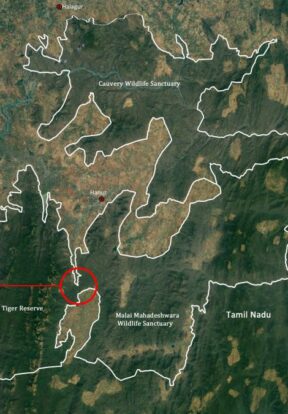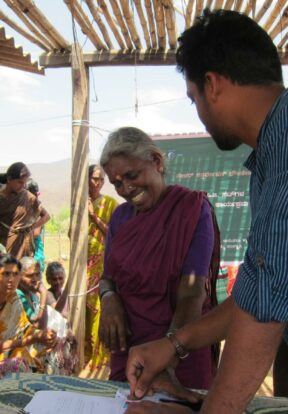Conservation Solutions: Fuelling Change

In Karnataka, India, conservationists have equipped women in villages with LPG cooking stoves, removing the need for firewood collection, an unsustainable activity during which they risk encounter with dangerous animals. The switch to LPG seems to have health benefits – an improvement in lung function from reduced air pollution – and has reduced the timing spent cooking, with positive social consequences.
Here, Sanjay Gubbi of the Indian NGO the Nature Conservation Foundation (a grantee of IUCN’s Integrated Tiger Habitat Conservation Programme) shares his experience from a conservation project in Karnataka, southern India. He shows how helping communities to switch to cooking on LPG gas has reduced the unsustainable collection of firewood, resulting in fewer incursions into the forest, fewer encounters with dangerous animals, less pollution, and better health. Women, traditionally responsible for much of the gathering and use of firewood, were instrumental in driving this change.
Out of the box and into the cooking fire
Sanjay Gubbi writes:
“When the results of an ecological study throw up conservation challenges we are forced to think of out-of-the-box solutions. That’s exactly what a study in the southern Indian state of Karnataka prompted us to do. The outcome of our study in the Malai Mahadeshwara Hills – Cauvery landscape, where I had gone to study large cats, showed a degradation of forest cover in some parts, possibly due to excessive livestock grazing and firewood collection. Several studies depict the impacts of these conservation challenges: negatively affecting regeneration of plant species, altering vegetation structures, changing flora and fauna, reducing wild herbivore densities and other factors – all of which affect large numbers of carnivores, such as tigers and dholes. So we decided to begin by driving a small change: reducing the dependency on firewood. The solution we found was to provide an alternative energy source, LPG, that was in-tune with the needs of communities, locally appropriate, implementable, sustainable in the long term, and affordable.
Surveying resource use
Initially we undertook a questionnaire to assess responses from those who were dependent on firewood for various purposes. From a sample of 2,673 households, an overwhelming majority (98%) preferred to change to Liquefied Petroleum Gas (LPG), a popular form of cooking fuel in our part of India. We also found that 26 species of trees were currently collected for firewood. Of these, 18 were also consumed by wildlife such as elephants, gaur, sambar, axis deer, barking deer, four-horned antelopes, and sloth bears, some of which are threatened species. Most of these animals are a prey of tigers and other large carnivores. Hence, harvesting such tree species directly impact the food sources for wild herbivores, on which in turn the survival of the carnivores depends.
Making connections for tigers and communities
We began our experiment of reducing human impacts on tigers in the Malai Mahadeshwara Hills Sanctuary (906 km2) and the Cauvery Sanctuary (1,027 km2). Given limited resources, the next challenge was to identify priority areas within these Sanctuaries. To the East, the Malai Mahadeshwara Hills Wildlife Sanctuary is connected to te Biligirirangaswamy Temple Tiger Reserve (570 km2) through a narrow, 1.6-km-long stretch of forest cover. We decided to first work with communities that were dependent on this forest corridor for firewood. This choice made both ecological and logical sense as large mammals such as tigers, elephants, dholes, and gaur are known to move through this corridor between the larger habitat patches. In addition, the Biligirirangaswamy Temple Tiger Reserve has probably reached its ecological carrying capacity for tigers, so that the Malai Mahadeshwara Hills – Cauvery landscape acts as an ideal sink area for tigers dispersing from the Biligirirangaswamy Temple Tiger Reserve.
We further identified priority areas within these two protected regions (including another internal corridor within the Malai Mahadeshwara Hills) where we should provide people with LPG cook stoves. Local communities were reluctant and doubtful of our offer, as many people had made similar promises in the past but never returned — sometimes even after collecting money as a co-investment. This mistrust was the biggest initial pushback. Hence we could not ask for a co-investment as there was deep suspicion, and for many the initial investment was unaffordable in any case.
We began by identifying positive-minded key persons within communities through outreach activities such as street theatre. Generally, after any activity in a village some persons came forward to discuss their problems and ask for alternative solutions, thus showing their willingness to work for their community and demonstrating leadership. We started by targeting these people, some of whom have since become our key anchors within the communities. But many families were reluctant to shift to a new method of cooking as they had concerns about safety, food taste, health risks, and the cost of refill bottles. To dispel these initial apprehensions, we produced a short educational film featuring some of the initial beneficiaries.
After initial discussions village committees were formed and conservation commitment agreements were drawn up, in return for initial investment provided under the project. Even though ecological impact measures take time to respond to conservation interventions, it is important to scientifically monitor any positive conservation effect against a benchmark. This will show whether our project meets the objectives, helps to identify the strengths and weaknesses, and ensures that various partners (e.g. communities, government, donors) can see its benefits. To quantify the impact of our conservation action, we monitored the use of firewood before and after providing people with LPG stoves, to measure the impact of the conservation action. From a sample of beneficiaries, we showed that the daily per capita firewood usage in the village of Lokkanahalli fell from 5.4 to 1.3 kg. Similarly, in the village of Meenyam, the reduction was from 2.1 to 1.1 kg. We also measured changes in the density of wildlife, and tracked a measure of forest cover — the so-called Normalised Difference Vegetation Index — with satellite imagery. (It is important to note that other factors (for example, improved forest protection by the government, or changing socio-economic factors) can affect to those ecological measures.) But because we realized that this ecological impact measure would be of limited interest to local communities, we also used up a socio-medical impact measure – i.e. improvements in human lung function – to demonstrate that the shift to LPG stoves not only benefits forests and wildlife, but also local people.
A breath of fresh air
Studies have shown a causal link between high incidences of Acute Respiratory Illness, Chronic Obstructive Pulmonary Disease, asthma, visual impairment, lung cancer, and cardiovascular diseases and the use of firewood, due to firewood causing significant indoor air pollution. These diseases impose a considerable health burden, especially on women. Hence, we tested the lung function of beneficiaries of the project before providing them with LPG stoves. Initial results (on 296 persons; 63.5% women) showed that 42.8% of women and 38.9% of men had reduced lung function. For women, the explanatory factor for reduced lung function was the use of firewood for a period of over 10 years, while it was smoking for men. We also showed that 20.2% of women with reduced lung function had developed chest problems such as chronic cough, breathlessness, and wheezing. These results clearly show the health hazard of firewood usage, especially to women, who spend a considerable proportion of time cooking. To assess the health benefits of switching to LPG, we will repeat the lung function tests on the beneficiaries one year into the project.
Previously, women who needed to collect firewood also faced the hardship of walking through tough terrain, where they run the risk of encounters with dangerous wildlife species, for example tigers. The use of LPG stoves removes the need for forest incursions. Furthermore, women reported another, unexpected, social benefit of switching to LPG, namely reduced cooking time, which allows them to work extra hours in the fields and to send children to school on time. So it’s not surprising that 80% of our beneficiaries are women, and that women have become the most important supporters of our conservation project.”











